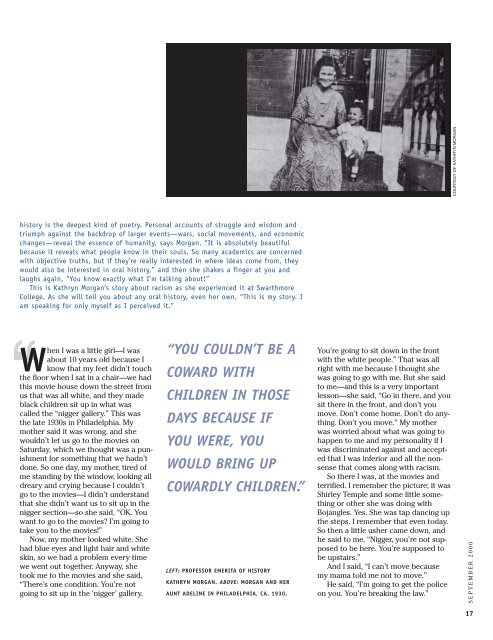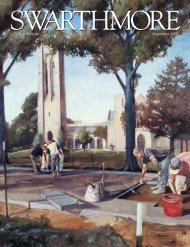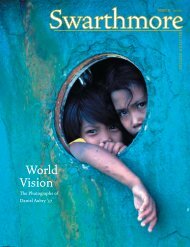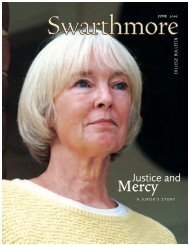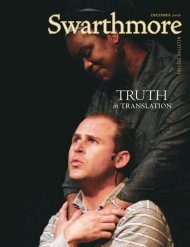D I S T U R B I N GT H EP E A C ES W A R T H M O R E C O L L E G E B U L L E T I NWhen I came toSwarthmore College inLounging on her sofa on a bright summer afternoon at Swarthmore’s Strath HavenCondominiums, the Sara Lawrence Lightfoot Professor Emerita of History KathrynMorgan grins and tells you she was not your typical Swarthmore professor. No sir,Morgan says, she was not typical at all. She was the first African-American woman tobe given tenure at Swarthmore; in fact, she was the first-ever African-American professorthe College hired.That was back in the early 1970s, and Morgan was a pioneer. A graduate of HowardUniversity, she completed her doctorate at the University of Pennsylvania, the onlyAfrican American in the program. “It takes a toll on you at times, it does, being theonly one,” she says. “When I came to Swarthmore, it was because I thought the studentshere needed me—not just the black students, but I knew they needed anAfrican American on the faculty. I mean, there wasn’t even one!”Today, Swarthmore has a much better record on faculty diversity. Of the 166 fulltimeinstructional faculty, 25 are minorities, and 14 of those are African American (8with tenure). Among the faculty hired into tenure-track positions in the last 5 years,25 percent are people of color.The College’s Minority Scholars in Residence Program, begun in the 1980s by PresidentDavid Fraser, has been an important strategy for bringing more people of coloronto the faculty, says Provost Jennie Keith. Minority scholars are invited to be residenton campus during the period just before or after they receive a Ph.D. The programprovides time to complete a dissertation or launch postdoctoral research—alongwith the opportunity to teach in a liberal arts setting. Several minority scholars havejoined the permanent faculty after this program.But when Kathryn Morgan first came to Swarthmore, there were no such programs.She was breaking new ground. “I was not what they were used to,” she remembersabout her interview with Harrison Wright, then-chair of the department. “I was not awhite person in black skin. I was a black woman, OK? And they hired me! They wantedme to come! That speaks well of Swarthmore!” she says, with her trademarklaugh—half-giggle, half-cackle.For more than 20 years, Morgan taught Swarthmore students oral history, folklore,and folklife—an alternative view of history preserved in oral tradition, sometimeshanded down from generation to generation. During her childhood in Philadelphia,Morgan was raised on those kinds of stories of her own mother’s families and hergreat-grandmother, Caddy Buffers, who was born a slave. Morgan’s book Children ofStrangers: The Stories of a Black Family is an oral history of her mother’s family.“I heard stories all my life,” she says. “This is the history that people kept alive.We need a history in which we can see ourselves reflected.” Morgan paraphrases aquote from one of her favorite thinkers and writers, W.E.B. DuBois: “History that hasbeen accurately written is just a pinpoint in the sea of human experiences,” she says.“He called attention to the significance of oral traditions. We all have stories. Andthe thing I like about oral history is the fact that it’s ever changing. It’s not static.”To Morgan, and to many students who felt history come alive in her courses, oral1970, it was quite anaccident. I never heardof Swarthmore, eventhough I was raisedin Philadelphia.JIM GRAHAMO FR A C I S MA N O R A L H I S T O R Y O F T H E O R A L H I S T O R I A N K A T H R Y N M O R G A NBy Laura Markowitz ’8516
COURTESY OF KATHRYN MORGANhistory is the deepest kind of poetry. Personal accounts of struggle and wisdom andtriumph against the backdrop of larger events—wars, social movements, and economicchanges—reveal the essence of humanity, says Morgan. “It is absolutely beautifulbecause it reveals what people know in their souls. So many academics are concernedwith objective truths, but if they’re really interested in where ideas come from, theywould also be interested in oral history,” and then she shakes a finger at you andlaughs again, “You know exactly what I’m talking about!”This is Kathryn Morgan’s story about racism as she experienced it at SwarthmoreCollege. As she will tell you about any oral history, even her own, “This is my story. Iam speaking for only myself as I perceived it.”“ WhenI was a little girl—I wasabout 10 years old because Iknow that my feet didn’t touchthe floor when I sat in a chair—we hadthis movie house down the street fromus that was all white, and they madeblack children sit up in what wascalled the “nigger gallery.” This wasthe late 1930s in Philadelphia. Mymother said it was wrong, and shewouldn’t let us go to the movies onSaturday, which we thought was a punishmentfor something that we hadn’tdone. So one day, my mother, tired ofme standing by the window, looking alldreary and crying because I couldn’tgo to the movies—I didn’t understandthat she didn’t want us to sit up in thenigger section—so she said, “OK. Youwant to go to the movies? I’m going totake you to the movies!”Now, my mother looked white. Shehad blue eyes and light hair and whiteskin, so we had a problem every timewe went out together. Anyway, shetook me to the movies and she said,“There’s one condition. You’re notgoing to sit up in the ‘nigger’ gallery.“YOU COULDN’T BE ACOWARD WITHCHILDREN IN THOSEDAYS BECAUSE IFYOU WERE, YOUWOULD BRING UPCOWARDLY CHILDREN.”LEFT: PROFESSOR EMERITA OF HISTORYKATHRYN MORGAN. ABOVE: MORGAN AND HERAUNT ADELINE IN PHILADELPHIA, CA. 1930.You’re going to sit down in the frontwith the white people.” That was allright with me because I thought shewas going to go with me. But she saidto me—and this is a very importantlesson—she said, “Go in there, and yousit there in the front, and don’t youmove. Don’t come home. Don’t do anything.Don’t you move.” My motherwas worried about what was going tohappen to me and my personality if Iwas discriminated against and acceptedthat I was inferior and all the nonsensethat comes along with racism.So there I was, at the movies andterrified. I remember the picture; it wasShirley Temple and some little somethingor other she was doing withBojangles. Yes. She was tap dancing upthe steps. I remember that even today.So then a little usher came down, andhe said to me, “Nigger, you’re not supposedto be here. You’re supposed tobe upstairs.”And I said, “I can’t move becausemy mama told me not to move.”He said, “I’m going to get the policeon you. You’re breaking the law.”S E P T E M B E R 2 0 0 017


